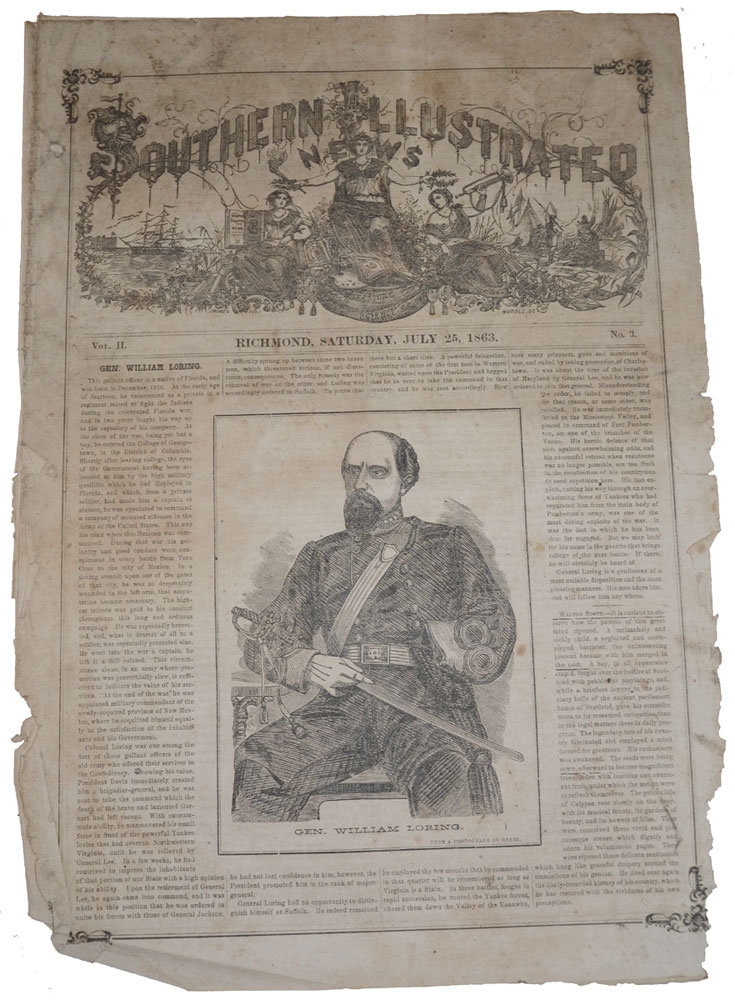site search
online catalog
SOUTHERN ILLUSTRATED NEWS--RICHMOND, VA, JULY 25, 1863

Hover to zoom




$150.00 SOLD
Quantity Available: None
Item Code: 959-11
Vol. 2/ No. 3. 8 pages, measuring 11.75 x 16.5”, with cover illustration. Exhibits moderate soiling and chipping round lower margins. Else good plus and entirely legible.
Front cover features illustration and biographical sketch of Rebel Gen. William Loring. Page 19 contains a review of British actress Fanny Kemble’s memoir of her life “On a Georgia Plantation,” which was scathing in its view of southern slavery. This issue also contains a response to the Harper Weekly piece, “A Typical Negro,” which featured an illustration of the famed image depicting the scarred back of a former slave, which had been recently published on July 4, 1863. In this issue The Southern Illustrated cites the Harper’s Weekly piece and responds by saying that “A more palpable falsehood was never published by any Yankee paper.”
This paper was launched in Richmond in September 1862 to provide the kind illustrated news which Harper’s Weekly and Frank Leslie’s Illustrated had provided southern readers prior to the outbreak of war. Although the magazine was unable to live up to its title by providing many illustrations, much less of quality, nonetheless it managed to stay afloat in Richmond through October 1863. Highly collectible, and especially with its reply to Harper’s Weekly concerning “The Typical Negro” image. Scarce. [sr]
~~~~~~~~~~~~~~~~~~~~~~~~~~~~~~~~~~~
THIS ITEM, AS WITH ALL OTHER ITEMS AVAILABLE ON OUR WEB SITE,
MAY BE PURCHASED THROUGH OUR LAYAWAY PROGRAM.
FOR OUR POLICIES AND TERMS,
CLICK ON ‘CONTACT US’ AT THE TOP OF ANY PAGE ON THE SITE,
THEN ON ‘LAYAWAY POLICY’.
Inquire About SOUTHERN ILLUSTRATED NEWS--RICHMOND, VA, JULY 25, 1863
Most Popular
Historical Firearms Stolen From The National Civil War Museum In Harrisburg, Pa »
Theft From Gravesite Of Gen. John Reynolds »
Selection Of Unframed Prints By Don Troiani »
Fine Condition Brass Infantry Bugle Insignia »
Large English Bowie Knife With Sheath 1870’S – 1880’S »
Imported (Clauberg) Us Model 1860 Light Cavalry Officer's Saber »
featured item
AN ASSEMBLAGE BOTH WAR AND POST WAR OF A GETTYSBURG "WOLVERINE” – WILLIAM H. DUNN, 5TH AND 10TH MICHIGAN CAVALRY
William H. Dunn of Ganges, Michigan served in both the 5th and 10th Michigan Cavalry during the Civil War. He enlisted on Aug. 14, 1862 in Co. "I" 5th Michigan Cavalry. At Gettysburg Dunn, a trooper in the famous charge lead by Custer, gallantly… (1268-779). Learn More »


